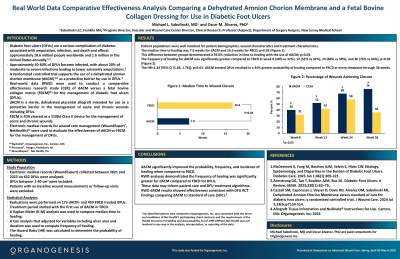Clinical Research
(CR-075) Real World Data Comparative Effectiveness Analysis Comparing a Dehydrated Amnion Chorion Membrane and a Fetal Bovine Collagen Dressing for Use in Diabetic Foot Ulcers
Friday, May 2, 2025
7:45 PM - 8:45 PM East Coast USA Time

Oscar Alvarez, PhD, FAPWCA, CCT – Adjunct Professor, Department of Surgery, Division of Plastic Surgery, Rutgers NJMS
Introduction: Using real-world data (RWD) we conducted a comparative effectiveness analysis (CEA) of a Dehydrated Amnion Chorion Membrane (dACM)(a) versus a Fetal Bovine Collagen Dressing (FBCD)(b) for the management of diabetic foot ulcers (DFUs).
Methods: Electronic medical records (WoundExpert®, NetHealth, PA)(c) collected between 2021 and 2023, on 632 DFUs were analyzed. Ulcers 1-40 cm2 were included. Patients with no baseline wound measurements or follow-up visits were excluded. Evaluations were performed on 173 dACM- and 459 FBCD treated DFUs. A Kaplan-Meier (K-M) analysis was used to compute median time to healing, and a Cox analysis that adjusted for variables including ulcer area and duration was used to compute frequency of healing. The Hazard Ratio (HR) was calculated to determine the probability of healing.
Results: Patient populations were well matched for patient demographics, wound characteristics and treatment characteristics. The median time to healing was 7.0 weeks for dACM and 16.6 weeks for FBCD; p=0.03. This difference between groups demonstrated a 39.8% reduction in time to healing with the use of dACM; p=0.03. The frequency of healing for dACM was significantly greater compared to FBCD at week 8 (40% vs 32%), 12 (52% vs 42%), 24 (68% vs 58%), and 36 (76% vs 66%); p=0.03. The HR=1.34 [95% CI (1.03, 1.76)]; p=0.03. dACM treated DFUs resulted in a 34% greater probability of healing compared to FBCD at every timepoint through 36 weeks.
Discussion: RWD analyses demonstrated the frequency of healing was significantly greater for dACM compared to FBCD for DFUs. These data may inform patient care and DFU treatment algorithms. RWD dACM results showed effectiveness consistent with DFU RCT findings comparing dACM to standard of care (SOC).1
Methods: Electronic medical records (WoundExpert®, NetHealth, PA)(c) collected between 2021 and 2023, on 632 DFUs were analyzed. Ulcers 1-40 cm2 were included. Patients with no baseline wound measurements or follow-up visits were excluded. Evaluations were performed on 173 dACM- and 459 FBCD treated DFUs. A Kaplan-Meier (K-M) analysis was used to compute median time to healing, and a Cox analysis that adjusted for variables including ulcer area and duration was used to compute frequency of healing. The Hazard Ratio (HR) was calculated to determine the probability of healing.
Results: Patient populations were well matched for patient demographics, wound characteristics and treatment characteristics. The median time to healing was 7.0 weeks for dACM and 16.6 weeks for FBCD; p=0.03. This difference between groups demonstrated a 39.8% reduction in time to healing with the use of dACM; p=0.03. The frequency of healing for dACM was significantly greater compared to FBCD at week 8 (40% vs 32%), 12 (52% vs 42%), 24 (68% vs 58%), and 36 (76% vs 66%); p=0.03. The HR=1.34 [95% CI (1.03, 1.76)]; p=0.03. dACM treated DFUs resulted in a 34% greater probability of healing compared to FBCD at every timepoint through 36 weeks.
Discussion: RWD analyses demonstrated the frequency of healing was significantly greater for dACM compared to FBCD for DFUs. These data may inform patient care and DFU treatment algorithms. RWD dACM results showed effectiveness consistent with DFU RCT findings comparing dACM to standard of care (SOC).1

.jpg)